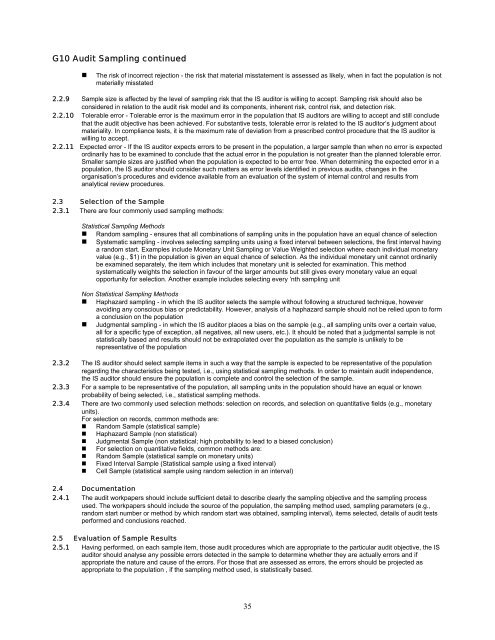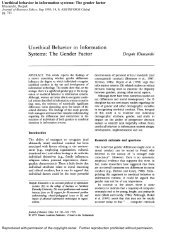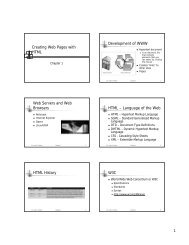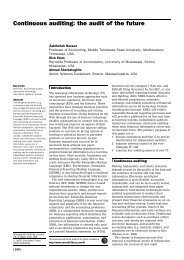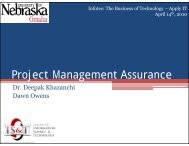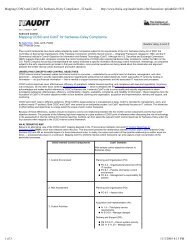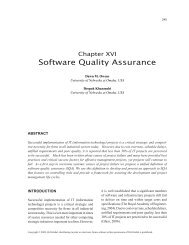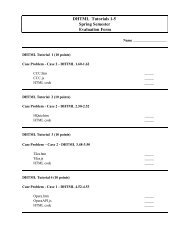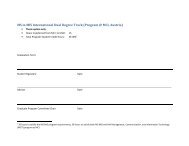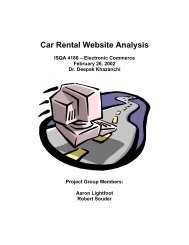IS Standards, Guidelines and Procedures for Auditing and Control ...
IS Standards, Guidelines and Procedures for Auditing and Control ...
IS Standards, Guidelines and Procedures for Auditing and Control ...
Create successful ePaper yourself
Turn your PDF publications into a flip-book with our unique Google optimized e-Paper software.
G10 Audit Sampling continued• The risk of incorrect rejection - the risk that material misstatement is assessed as likely, when in fact the population is notmaterially misstated2.2.9 Sample size is affected by the level of sampling risk that the <strong>IS</strong> auditor is willing to accept. Sampling risk should also beconsidered in relation to the audit risk model <strong>and</strong> its components, inherent risk, control risk, <strong>and</strong> detection risk.2.2.10 Tolerable error - Tolerable error is the maximum error in the population that <strong>IS</strong> auditors are willing to accept <strong>and</strong> still concludethat the audit objective has been achieved. For substantive tests, tolerable error is related to the <strong>IS</strong> auditor’s judgment aboutmateriality. In compliance tests, it is the maximum rate of deviation from a prescribed control procedure that the <strong>IS</strong> auditor iswilling to accept.2.2.11 Expected error - If the <strong>IS</strong> auditor expects errors to be present in the population, a larger sample than when no error is expectedordinarily has to be examined to conclude that the actual error in the population is not greater than the planned tolerable error.Smaller sample sizes are justified when the population is expected to be error free. When determining the expected error in apopulation, the <strong>IS</strong> auditor should consider such matters as error levels identified in previous audits, changes in theorganisation’s procedures <strong>and</strong> evidence available from an evaluation of the system of internal control <strong>and</strong> results fromanalytical review procedures.2.3 Selection of the Sample2.3.1 There are four commonly used sampling methods:Statistical Sampling Methods• R<strong>and</strong>om sampling - ensures that all combinations of sampling units in the population have an equal chance of selection• Systematic sampling - involves selecting sampling units using a fixed interval between selections, the first interval havinga r<strong>and</strong>om start. Examples include Monetary Unit Sampling or Value Weighted selection where each individual monetaryvalue (e.g., $1) in the population is given an equal chance of selection. As the individual monetary unit cannot ordinarilybe examined separately, the item which includes that monetary unit is selected <strong>for</strong> examination. This methodsystematically weights the selection in favour of the larger amounts but still gives every monetary value an equalopportunity <strong>for</strong> selection. Another example includes selecting every ‘nth sampling unitNon Statistical Sampling Methods• Haphazard sampling - in which the <strong>IS</strong> auditor selects the sample without following a structured technique, howeveravoiding any conscious bias or predictability. However, analysis of a haphazard sample should not be relied upon to <strong>for</strong>ma conclusion on the population• Judgmental sampling - in which the <strong>IS</strong> auditor places a bias on the sample (e.g., all sampling units over a certain value,all <strong>for</strong> a specific type of exception, all negatives, all new users, etc.). It should be noted that a judgmental sample is notstatistically based <strong>and</strong> results should not be extrapolated over the population as the sample is unlikely to berepresentative of the population2.3.2 The <strong>IS</strong> auditor should select sample items in such a way that the sample is expected to be representative of the populationregarding the characteristics being tested, i.e., using statistical sampling methods. In order to maintain audit independence,the <strong>IS</strong> auditor should ensure the population is complete <strong>and</strong> control the selection of the sample.2.3.3 For a sample to be representative of the population, all sampling units in the population should have an equal or knownprobability of being selected, i.e., statistical sampling methods.2.3.4 There are two commonly used selection methods: selection on records, <strong>and</strong> selection on quantitative fields (e.g., monetaryunits).For selection on records, common methods are:• R<strong>and</strong>om Sample (statistical sample)• Haphazard Sample (non statistical)• Judgmental Sample (non statistical; high probability to lead to a biased conclusion)• For selection on quantitative fields, common methods are:• R<strong>and</strong>om Sample (statistical sample on monetary units)• Fixed Interval Sample (Statistical sample using a fixed interval)• Cell Sample (statistical sample using r<strong>and</strong>om selection in an interval)2.4 Documentation2.4.1 The audit workpapers should include sufficient detail to describe clearly the sampling objective <strong>and</strong> the sampling processused. The workpapers should include the source of the population, the sampling method used, sampling parameters (e.g.,r<strong>and</strong>om start number or method by which r<strong>and</strong>om start was obtained, sampling interval), items selected, details of audit testsper<strong>for</strong>med <strong>and</strong> conclusions reached.2.5 Evaluation of Sample Results2.5.1 Having per<strong>for</strong>med, on each sample item, those audit procedures which are appropriate to the particular audit objective, the <strong>IS</strong>auditor should analyse any possible errors detected in the sample to determine whether they are actually errors <strong>and</strong> ifappropriate the nature <strong>and</strong> cause of the errors. For those that are assessed as errors, the errors should be projected asappropriate to the population , if the sampling method used, is statistically based.35


